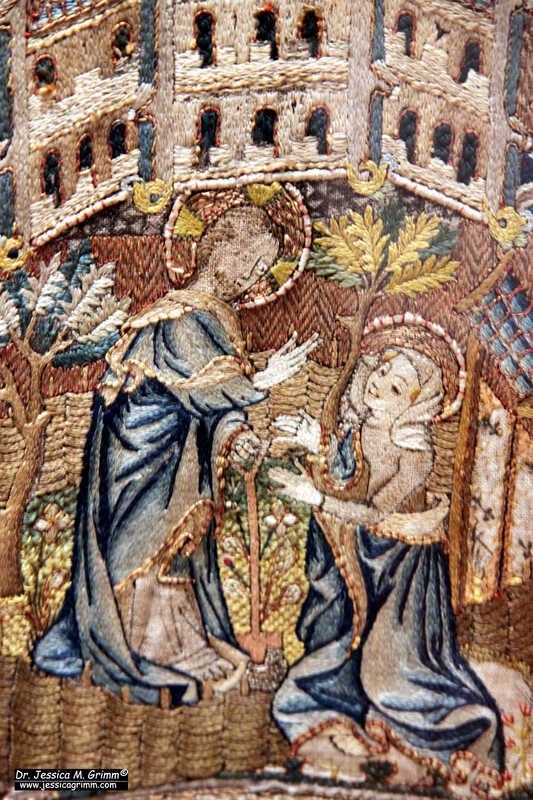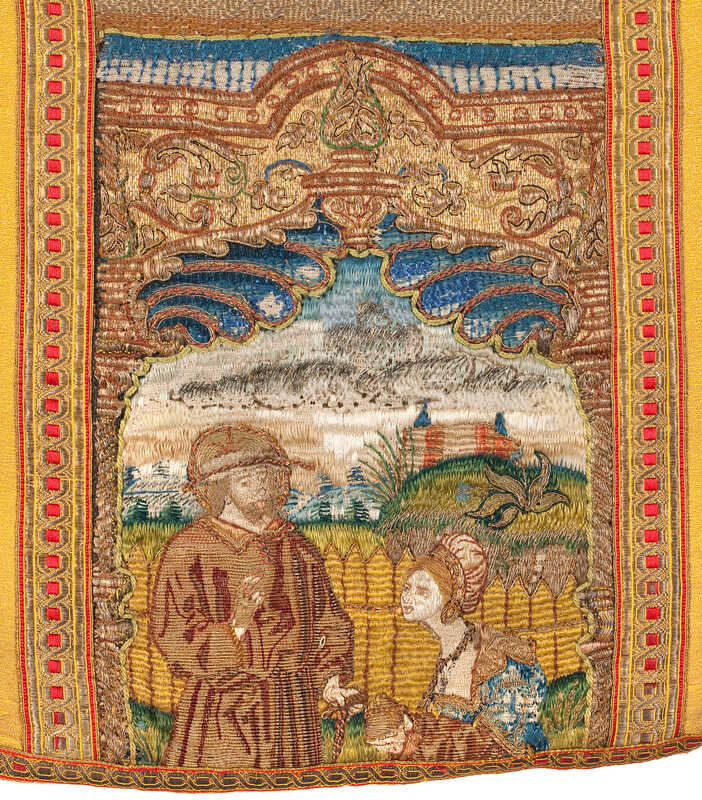|
In the last few years, there's been an increased focus on the benefit of needlework on your mental health. However, 'modern' principles of good mental health are sometimes also depicted in medieval embroidery itself. One such famous depiction is the scene of 'Noli me tangere' (cease holding on to me). It is based on a biblical story in the gospel of St John. Mary Magdalene returns to the grave site. She talks to a man whom she thinks is the gardener. He tells her not to hold onto him when she finally recognises him to be Jesus. Their former relationship has to change. Depending on what you believe, this is either because Jesus has died or because he just became responsible for the salvation of mankind and is now kinda busy. Either way, they need to let go of what has been. Being able to properly let go is a sign of good mental health. Let's have a look at the different depictions of this intimate encounter. Among the 1650 pieces of medieval goldwork embroidery, only 21 depict this particular scene. It is clearly not overly popular, but also not completely rare. The oldest pieces date to the 13th century and the youngest to the 16th century. By pulling them together, you start to observe some interesting things. Firstly, most of the embroideries depict Jesus as the risen Christ and not as a gardener. The first 'gardener-Jesus' is depicted on a cope from the St Marienkirche in Danzig (now Gdansk, Poland) (kept at St Annenmuseum Lübeck). It dates from after AD 1460 (but probably not long after). Between AD 1520 and 1530, the 'gardener-Jesus' becomes the norm. And you can clearly tell that the embroiderer knew what a gardener looked like and what equipment they used. In fact, the depiction of Jesus' shovel is so accurate, that medieval archaeologists have no trouble matching them to excavated originals. In the above picture, the brown silk embroidery represents the wooden part of the shovel and the silver threads depict the iron 'shoe' which protects the wooden edge and hardens it for digging. Neat, don't you think? Putting the 21 embroideries in chronological order also shows developments in embroidery techniques and materials. The two oldest pieces from the 13th century are very different. One is a case of Opus florentinum from Italy (kept in the Aachener Domschatz, inv. nr. T 01001). It shows this characteristic treatment of the golden background: string padding in the form of foliage. The gold threads have been couched over it to create an embossed look (as I don't own a picture of this piece, please compare it with this piece from the MET 60.148.1). The other piece, the so-called Hedwigkasel (now kept in the Muzeum Archidiecezjalne we Wroclawiu, nr inw. 23/29a), is very different indeed. It is worked on red silk and reminds a bit of the earlier Opus anglicanum pieces. The figures are completely worked in metal thread embroidery. Many different, often very intricate, diaper patterns have been used to fill in the different parts of the figures. It even looks like the embroidery is done in underside couching. In the later pieces, we see an increased use of the or nue technique. In the beginning (late 15th century), it is only used on parts of the clothing of the most important figure in the scene. Pieces from the 16th century, often show the use of or nue for the full width of the orphrey. Only bare skin is voided. Figures and background are worked in one go. And whilst the youngest piece is also one of the finest when it comes to the execution of the embroidery, two slightly younger pieces show the decline likely caused by the Reformation. And then there was this absolutely thrilling discovery of another 'twin image'. A chasuble (inv. nr. 138) held in the Frankfurter Domschatz shares an identical depiction of Noli me tangere with a chasuble (inv. nr. BMH t2912a) from the Museum Catherijneconvent. The embroidery techniques used differ a bit, but the design drawing is identical. I have alerted both museums to the discovery just in case they are unaware. As there seems to be little known about the piece in the Netherlands, finding a twin on a piece with known provenance is always very nice!
My Journeyman and Master Patrons have access to a Padlet on which all 21 pieces are introduced.
2 Comments
12/4/2023 08:56:29
I find it fascinating why certain images are more popular than others and then see it change through time. Why people believe what they believe and what it does for them is something I will never grow tired of!
Reply
Your comment will be posted after it is approved.
Leave a Reply. |
Want to keep up with my embroidery adventures? Sign up for my weekly Newsletter to get notified of new blogs, courses and workshops!
Liked my blog? Please consider making a donation or becoming a Patron so that I can keep up the good work and my blog ad-free!
Categories
All
Archives
July 2024
|
Contact: info(at)jessicagrimm.com
Copyright Dr Jessica M. Grimm - Mandlweg 3, 82488 Ettal, Deutschland - +49(0)8822 2782219 (Monday, Tuesday, Friday & Saturday 9.00-17.00 CET)
Impressum - Legal Notice - Datenschutzerklärung - Privacy Policy - Webshop ABG - Widerrufsrecht - Disclaimer
Copyright Dr Jessica M. Grimm - Mandlweg 3, 82488 Ettal, Deutschland - +49(0)8822 2782219 (Monday, Tuesday, Friday & Saturday 9.00-17.00 CET)
Impressum - Legal Notice - Datenschutzerklärung - Privacy Policy - Webshop ABG - Widerrufsrecht - Disclaimer










 RSS Feed
RSS Feed